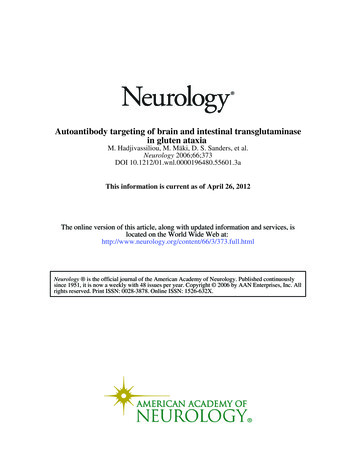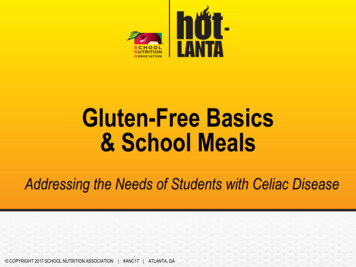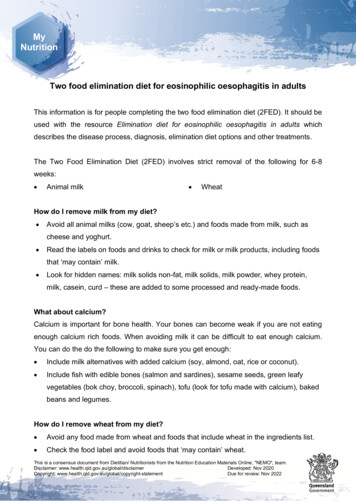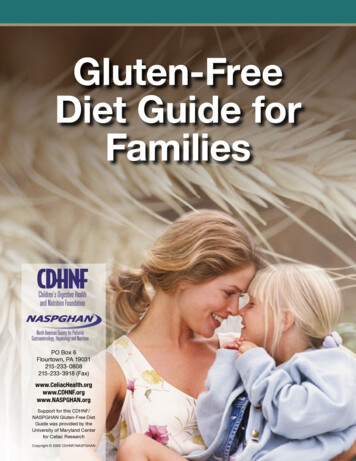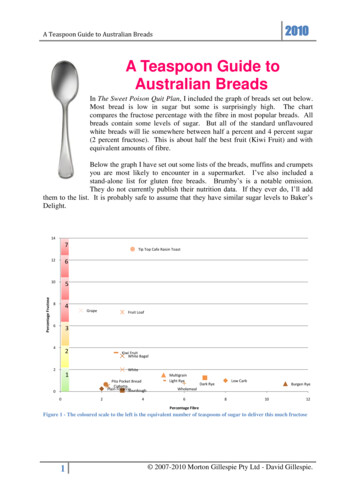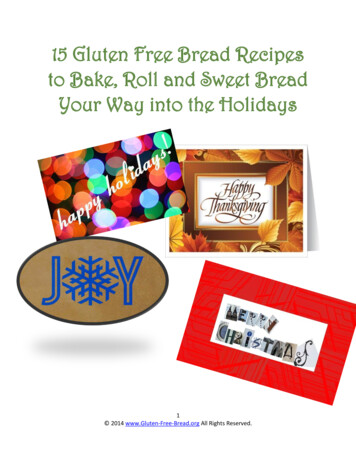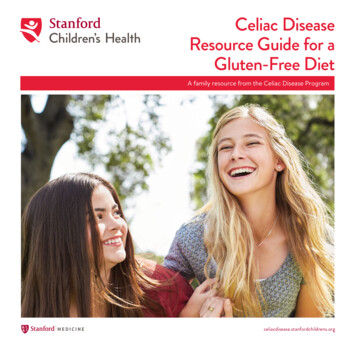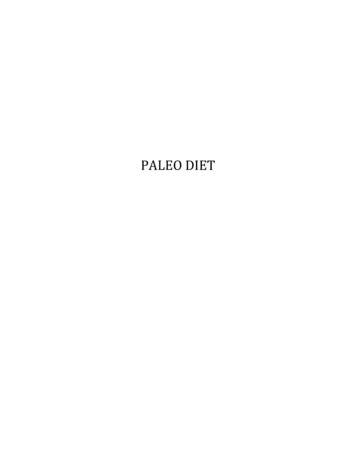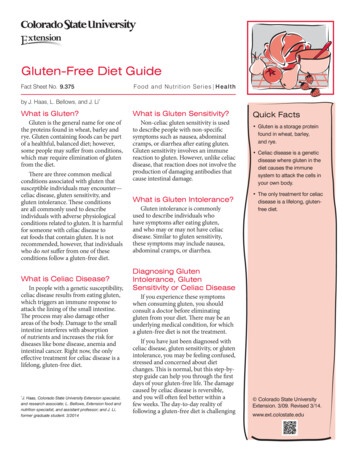
Transcription
Gluten-Free Diet GuideFact Sheet No. 9.375Food and Nutrition Series Healthby J. Haas, L. Bellows, and J. Li*What is Gluten?What is Gluten Sensitivity?Gluten is the general name for one ofthe proteins found in wheat, barley andrye. Gluten containing foods can be partof a healthful, balanced diet; however,some people may suffer from conditions,which may require elimination of glutenfrom the diet.There are three common medicalconditions associated with gluten thatsusceptible individuals may encounter—celiac disease, gluten sensitivity, andgluten intolerance. These conditionsare all commonly used to describeindividuals with adverse physiologicalconditions related to gluten. It is harmfulfor someone with celiac disease toeat foods that contain gluten. It is notrecommended, however, that individualswho do not suffer from one of theseconditions follow a gluten-free diet.Non-celiac gluten sensitivity is usedto describe people with non-specificsymptoms such as nausea, abdominalcramps, or diarrhea after eating gluten.Gluten sensitivity involves an immunereaction to gluten. However, unlike celiacdisease, that reaction does not involve theproduction of damaging antibodies thatcause intestinal damage.What is Celiac Disease?In people with a genetic susceptibility,celiac disease results from eating gluten,which triggers an immune response toattack the lining of the small intestine.The process may also damage otherareas of the body. Damage to the smallintestine interferes with absorptionof nutrients and increases the risk fordiseases like bone disease, anemia andintestinal cancer. Right now, the onlyeffective treatment for celiac disease is alifelong, gluten-free diet.J. Haas, Colorado State University Extension specialist,and research associate; L. Bellows, Extension food andnutrition specialist, and assistant professor; and J. Li,former graduate student. 3/2014*What is Gluten Intolerance?Gluten intolerance is commonlyused to describe individuals whohave symptoms after eating gluten,and who may or may not have celiacdisease. Similar to gluten sensitivity,these symptoms may include nausea,abdominal cramps, or diarrhea.Quick Facts Gluten is a storage proteinfound in wheat, barley,and rye. Celiac disease is a geneticdisease where gluten in thediet causes the immunesystem to attack the cells inyour own body. The only treatment for celiacdisease is a lifelong, glutenfree diet.Diagnosing GlutenIntolerance, GlutenSensitivity or Celiac DiseaseIf you experience these symptomswhen consuming gluten, you shouldconsult a doctor before eliminatinggluten from your diet. There may be anunderlying medical condition, for whicha gluten-free diet is not the treatment.If you have just been diagnosed withceliac disease, gluten sensitivity, or glutenintolerance, you may be feeling confused,stressed and concerned about dietchanges. This is normal, but this step-bystep guide can help you through the firstdays of your gluten-free life. The damagecaused by celiac disease is reversible,and you will often feel better within afew weeks. The day-to-day reality offollowing a gluten-free diet is challenging Colorado State UniversityExtension. 3/09. Revised 3/14.www.ext.colostate.edu
in the beginning, but it can be doneand will get easier with practice. Evenif you don’t feel sick after eating glutencontaining foods, you can still damageyour body. While avoiding glutencontaining foods may seem difficult atfirst, it is easy to identify them once youare familiar with their names. To getstarted, see the list of gluten-containingfoods and ingredients provided at theend of this fact sheet (List 1). Take thelist with you when you shop or eat out.10 Steps to the GlutenFree DietSwitching to a gluten-free dietcan be difficult in the beginning.Following these 10 steps can make thechanges easier.Step 1. Identify Naturally Gluten-FreeFoods at HomeMany foods are naturally glutenfree. Before you buy expensive storebought gluten-free breads and cereals,look in your kitchen cupboards andrefrigerator for the following items.Note that ‘Plain’ refers to no additives. Fresh fruits Fresh beef, pork, chicken, turkey,fish, and seafood Fresh eggs Fresh, plain milk, butter,margarine, cream Plain beans Plain corn Plain white rice, brown rice,wild rice Plain nuts and seeds Oils Sugar, honey, molasses Spices and herbsStep 2. Identify Gluten-Free PackagedFoods at HomeNext, take out all of the packagedfoods with food labels and put themon your kitchen table. Some packagedfoods have gluten hidden in theingredients. A list of Common Sourcesof Hidden Gluten is provided for youat the end of this fact sheet (List 2).Read the ingredient lists. If you findany sources of gluten in the ingredients,do not eat that food. You can eitherget rid of the gluten-containing foodsor place them in a separate part of thecabinet so others in the household caneat them. Labeling laws now requirewheat ingredients to be clearly labeled,however this does not necessarily meanthe food is gluten-free. A gluten-freelabel, on the other hand, identifies afood that is safe to eat.Step 3. Plan One Week's Menuaround Naturally Gluten-Free FoodsLooking for a place to start? Trythese suggestions:Breakfasts Cream of rice cereal with freshfruit or nuts Cottage cheese or yogurt withfresh fruit Scrambled eggs, bacon andfresh fruit Egg, cheese, and vegetable omeletwith potatoes and fresh fruitLunches and Dinners Baked potato with cheeseand vegetables Corn tortillas with stir-fried meatand vegetables Stir-fried meat and vegetableswith rice and wheat-free tamari Bean-and-cheese burritos madewith corn tortillas Grilled meat or fish, baked potatoand vegetablesSnacks Plain rice cakes with cheese orpeanut butter Nachos made with plain cornchips, cheese and salsa Celery sticks with cream cheeseor peanut butter String cheese Plain popcorn with oil and salt Fresh or canned fruit with yogurtor ice creamStep 4. Make a Gluten-Free ShoppingListAfter you have planned your oneweek’s menu, make a gluten-freeshopping list for foods you wish to buy.See sample Gluten-Free Shopping List(List 3) at the end of this fact sheet.Step 5. Read Food Labels Every TimeYou BuySome, but not all products will belabeled as gluten-free. Ingredients maychange over time for the same brandproduct. For foods that are not labeledas gluten-free, be sure to check theingredients for hidden gluten everytime you buy a packaged product. Takethe Shopping Guide: Sources of Gluten(List 4) provided at the end of thisfact sheet with you when you go foodshopping. However, when purchasingitems with a gluten-free label, youcan be sure that it is gluten-free. InAugust 2013, the U.S. Food and DrugAdministration (FDA) published a newregulation defining the term "glutenfree" for food labeling. The regulationprovides a uniform standard definition.So, if a manufacturer labels a product"gluten-free," the food must meet allof the requirements of the definition,including that the food must containless than 20 parts per million of gluten.The rule also requires foods with theclaims “no gluten,” “free of gluten,” and“without gluten” to meet the definitionfor “gluten-free.”Step 6. Avoid Cross-ContactIf you also shop and preparefood for people who do eat glutencontaining foods, it is important toprotect your gluten-free foods fromcontact with gluten. Buy two jars of jam, mayonnaise,and peanut butter. One is for you,and the other is for everyone else. Aknife with bread crumbs will leavegluten behind in a shared jar. Besure to label which jar is gluten-free.You can also buy squeeze bottles sonobody needs to use a knife. Buy a separate toaster for glutenfree breads, or put clean aluminumfoil on the rack of your toaster oven
when you use it for gluten-freeproducts. Buy a separate colander/strainer for gluten-free pasta.Colanders are too hard to clean tocompletely remove gluten. Colorcoding with a permanent markercan help keep all kitchen utensilsseparate.Clean counter tops and cuttingboards often to remove glutencontaining crumbs.Clean cooking utensils, knives, pans,grills, thermometers, cloths, andsponges carefully after each use andbefore cooking gluten-free foods.Store gluten-free foods abovegluten-containing foods in yourrefrigerator and cupboards. Bydoing this you prevent the risk ofgluten-containing food particlesfalling below onto gluten-free foods,causing contamination.Use pure spices rather than blends.If you bake with gluten-containingflours, put away or cover yourgluten-free foods when you bake.Flour dust can float in the air forseveral hours and contaminate yourgluten-free products.Avoid purchasing staplesfrom bulk bins to minimizecross contamination.Step 7. Eat Out and Travel GlutenFree with EaseYou can eat out at restaurants.Although there is concern for crosscontact when you eat out, you canreduce the risk by planning ahead. Before you leave home, do a littlehomework. Many restaurants havea website where they post theirmenus. Write down all the choicesthat are gluten-free. Often a menuwith gluten-free options is availableon request. Avoid bakery-type restaurantsor pizza places where the glutencontaining flour can stay in theair and come in contact withother foods. Call ahead and talk to the manageror chef about items that are preparedgluten-free. Make your first visit to a restaurantbefore or after peak dining hours sothe staff has enough time to answeryour questions. Always identify yourself as someonewho is allergic to wheat, rye andbarley. Though many people maybe familiar with the term “glutenfree,” they may not know what foodscontain gluten. Bring your owngluten-free food when traveling.This way, you will always havesomething you can eat. Apples,raisins, fruit leather, rice cakes, andnuts are good travel snacks. Always ask how the food isprepared. Talk to the manageror chef if your server doesn’tknow. Some specific questions toask include: Is the meat marinated insoy sauce, teriyaki sauce, orWorcestershire sauce? Is the chicken dusted with flourbefore pan-frying? Is the oil used for French fries alsoused for frying onion rings (orother breaded foods)? Are there croutons or bacon bitson the salad? Do you use wheat flour to makethe gravy (or thicken the soup)? If your meals will be preparedfor you (hospital, college dininghall), ask to speak with thedietary manager.Step 8. Eat a Balanced DietPeople on a gluten-free diet maynot get enough calcium, vitamin D,iron, B vitamins, or fiber. For example,many gluten-free breads, cereals, andpasta are not fortified with vitaminsand may be low in fiber. Are you gettingenough nutrients from your diet? Ifnot, be sure to include some nutrientdense gluten-free foods listed belowand/or take a multivitamin and mineralsupplement. Additionally, look for“whole grain” versions that contain thebran layer (rice bran, brown rice, brownrice flour). Variety is key to maximizeprotein, fiber, and nutrients.Step 9. Identify Any Additional FoodIntolerancesIf you are not feeling better on agluten-free diet, you may have otherfood intolerances such as lactose (milksugar), cow’s milk, soy, corn, eggs,nuts, yeast, and acidic foods. Talk toyour doctor and registered dietitian ifyou are not feeling better on a glutenfree diet.Step 10. Get SupportFor a successful transition to thegluten-free lifestyle, you need supportfrom your doctor, dietitian, family,friends, and others.If you have celiac disease, joining alocal support group can be very helpful.Individuals in this group understandwhat you are going through better thananyone else. They will be able to offeryou emotional support and answerall many of the questions you have.For a list of support groups, see theResources section.ResourcesMajor National Celiac Support Groups(they will give you information onlocal groups)Gluten Intolerance Groupwww.gluten.netCeliac Disease Foundationwww.celiac.orgTable 1. Nutrient Dense, Gluten-Free FoodsCalciumMilk, yogurt, cheese, sardines and salmon with bone, broccoli, collard greens,almonds, calcium-fortified juice, amaranth, teff, quinoaIronMeat, fish, chicken, beans, nuts, seeds, eggs, amaranth, quinoa, teffB vitaminsEggs, milk, meat, fish, orange juice, beans, nuts, seeds, gluten-free whole grainsVitamin DVitamin D-fortified milk and yogurt, egg yolks, salmon, sardines, tunaFiberVegetables, fruits, beans, amaranth, quinoa, millet, buckwheat, sorghum, teff, flax
d yeastEmmerMalt extract, maltsyrup, malt flavoring,malt vinegarSoy sauceCeliac Sprue Association-USAwww.csaceliacs.infoCanadian Celiac Associationwww.celiac.caBarley (pearl, flakes,flour)FarinaMalted milkSpeltProfessional andGovernment WebsitesBeer (gluten-free beeris available)Faro/FarroMatzohTriticaleBrewer’s yeastFuModified food starchWheatBulgurGluten, gluten flourOats*Wheat branChapattiGraham flourOrzoWheat flourCouscousHydrolyzed vegetable/plant proteinRyeWheat germDinkelKamutSeasoningWheat starchList 1. Gluten-Containing Foods and Ingredients (This is not a complete list.)*Those labeled gluten-free are fine. Oats do not contain gluten, but have the risk of cross-contactduring harvesting or processing.List 2. Common Sources of Hidden Gluten (This is not a complete list.)Baked beansFlavoringMarinadesSeasoningsBlue cheese crumblesFrench friesMeat loafSelf-basting poultryBreadingGravyNutsSoups, soup basesBroth, bouillonHerbal TeasProcessed meatSoy sauceCandyIce creamPuddingsStuffingCereal bindingIcing/frostingRice mixesThickenersChocolatesImitation seafoodRouxVegetarian “burgers”Color (artificial,caramel)Imitation baconSalad dressingsCommunion wafersLicoriceSaucesDry roasted nutsMaltodextrinSausageCarrotsGrapesThe Essential Gluten-FreeRestaurant ryOrangesBananasFruitsApplesMeat, r cheeseCream cheese*Yogurt*Cottage cheese*Sour creamGuar terBinders (for baking)Xanthan gumGuides for Gluten-FreeDining Out and TravelBob and Ruth’s Gluten-Free Dining &Travel Clubwww.bobandruths.comGluten Free on the Gowww.gluten-free-onthego.comGluten-free RestaurantAwareness Programwww.glutenfreerestaurants.orgList 3. Sample Gluten-Free Shopping ListLettuceAmerican Dietetic Associationwww.eatright.orgCeliac Disease Center atColumbia ac Disease and Gluten-freeResourcewww.celiac.comCenter for Celiac Research &Treatment at MassGeneral Hospital forChildrenww.celiaccenter.orgNational Institutes of s/celiac/University of Chicago CeliacDisease x.phpFrozen FoodsGluten-free wafflesTriumph Dining Cardswww.triumphdining.comCeliac Chickswww.celiacchicks.com/CF-HOME.htmWaiter, is There Wheat in my Soup?The Offiicial Guide to Dining Out,Shopping, and Traveling Gluten-Freeand Allergen-Freeby LynnRae Rieswww.whatnowheat.com
BooksList 3. Sample Gluten-Free Shopping List (continued)Canned and Packaged FoodsPeachesPearsGreen beansDried beansRice* (all forms, otato flour, starchTeffMilletBean flours (garbanzo,fava)SorghumTapioca (manioc,cassava)Gluten-free GrainsCornMagazinesSnacksPopcorn*Corn chips*Rice cakes, ricecrackers*Potato chips*Nuts and seeds*JelloCondimentsHoneyJams, jellies,marmaladeHerbsPicklesKetchupCorn and maple syrupSaltVinegarsMustardSugarPepperRegular mayonnaiseand salad dressings*Peanut butterSpicesOlivesVegetable oilsCoffeeTeaDrinksFruit juice100 Best Gluten-Free Recipesby Carol gluten-free-recipes/Easy Everyday Gluten-Free Cookingby Donna Washburn and Heather Buttwww.csaceliacs.info/shop.jsp*With no gluten-containing additives.List 4. Shopping Guide: Sources of Gluten (This is not a complete list. If in doubt, choose anotherbrand.) Read labels every time you buy! Ingredients can change at any time.Foods to AvoidAleDinkelLagerSeasoningsAttaDry roasted nutsLicoriceSeitanAutolyzed yeastDurumMaltSelf-basting poultryBaked beansEinkornMalt extract, maltsyrup, malt flavoringSemolinaBarley (pearl, flakes,flour)EmmerMalted milkSoups, soup basesBeer (gluten-free beeris available)FarinaMarinadesSoy sauceBreadingFaroMatzohSpeltBrewer’s yeastFlavoringMeat loafStuffingBroth, bouillonFuModified food starchTextured vegetableprotein (TVP)Brown rice syrupGelatinized starchMono- anddi-glyceridesThickenersBulgurGraham flourOats (not labeledgluten-free)TriticaleCereal bindingGravyProcessed meatWheatChocolate barsHydrolyzed vegetable/plant proteinRouxWheat branColor (artificial,caramel)Icing/frostingRyeWheat flourCommunion wafersImitation seafoodSalad dressingsWheat germCouscousImitation baconSaucesWheat starchDextrinKamutSausageGluten-Free Livingwww.glutenfreeliving.comSully’s Living Without Magazinewww.livingwithout.comReferencesCase, S., Heap, J., Raymond, N. (2006).The Gluten-Free Diet: An Updatefor Health Professionals. PracticalGastroenterology. 67-92.Children’s Digestive Health and NutritionFoundation. (2005). Gluten-Free DietGuide for Families. Retrieved pdf/diseaseinfo/glutenfreedietguide-e.pdfCranney, A. et al. (2007) The CanadianCeliac Health Survey. Dig Dis Sci. 52(4)1087-95.Cureton, P. (2006) Gluten-Free Dining Out:Is It Safe? Practical Gastroenterology.61-68.Mahan, L., Escott-Stump, S., and Raymond,J. (2012). Food and the Nutrition CareProcess. St. Louise, Missouri: ElsevierSaunders.Niewinski, M. (2008). Advances in CeliacDisease and Gluten-Free Diet. Journal ofthe American Dietetic Association. 108(4), 661–672.Pagano, A. E. (2006). Whole Grainsand the Gluten-Free Diet. PracticalGastroenterology. 66-78.Thompson, T. et al. (2005). Gluten-freeDiet Survey: Are Americans with CeliacDisease Consuming RecommendedAmounts of Fiber, Iron, Calcium andGrain Foods? J Hum Nutr Diet. 18(3),163-9.U.S. Food and Drug Administration.(2013). FDA defines “gluten-free” forfood labeling. Retrieved from: cements/ucm363474.htmlColorado State University, U.S. Department of Agriculture and Colorado counties cooperating. CSU Extension programs are available to all without discrimination.No endorsement of products mentioned is intended nor is criticism implied of products not mentioned.
Step 4. Make a Gluten-Free Shopping List After you have planned your one week's menu, make a gluten-free shopping list for foods you wish to buy. See sample Gluten-Free Shopping List (List 3) at the end of this fact sheet. Step 5. Read Food Labels Every Time You Buy Some, but not all products will be labeled as gluten-free. Ingredients may
